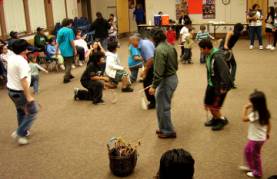 |
Soaring
Eagle Sentinel
|
By Roy Cook
 Soaring
Eagle American Indian SCAIR instructor Chuck Cadotte is starting ‘Duck
and dive’ instruction, in the performance dance sequence. Many American
Indian songs describe certain events or are familiar to native speakers
within their vocals or percussive elements. There are a couple of dances
that relate to the prairie chicken and a special dance and song called
the duck and dive, which depicted the Nez Perce battle at Big Hole in
Montana.
Soaring
Eagle American Indian SCAIR instructor Chuck Cadotte is starting ‘Duck
and dive’ instruction, in the performance dance sequence. Many American
Indian songs describe certain events or are familiar to native speakers
within their vocals or percussive elements. There are a couple of dances
that relate to the prairie chicken and a special dance and song called
the duck and dive, which depicted the Nez Perce battle at Big Hole in
Montana.
Historical background about the Nez Perce country in the Northwest included the territory where Washington, Oregon, and Idaho join together. From the beginning, with the tribe’s first contact with the explorers Meriwether Lewis and William Clark, the peaceful Nez Perce had befriended and cooperated with the Americans. Even when hordes of white settlers began to flood into their homelands along the Snake River (around the present-day intersection of the Oregon, Washington, and Idaho state borders), most of the Nez Perce peacefully moved to a reservation. When the Treaty of 1863 decreased their lands to one-tenth its original size, some of the Nez Perce bands refused to agree and became known as “non-treaty” Nez Perce. When the U.S. Army was sent to make a show of force, the Nez Perce drove them back, and the Nez Perce War of 1877 began. They initially hoped the Crow Indians, their hunting partners on the Plains, would give them shelter once they crossed the Rocky Mountains. When the Crows instead attacked them and stole horses, the last chance for the Nez Perce was flight into Canada where they might live with Sitting Bull’s Sioux.
The Big Hole courageous and tragic battle of the Nez Perce War was in August 1877. Fleeing eastward to avoid US aggression and with hopes of escaping to Canada, the Nez Perce made camp in the Big Hole Basin in present-day western Montana. At 3:30 a.m., Colonel John Gibbon attacked the sleeping Indians with a force of 183 men. Raking the Indian lodges with withering rifle fire, the soldiers initially seemed to be victorious. The Nez Perce, however, soon counterattacked from concealed positions in the surrounding hills. After four days of sporadic fighting, the Nez Perce overcame Gibbon, destroyed a mountain howitzer and captured the supply train. Both sides suffered serious casualties. The soldiers lost 29 men with 40 wounded. The Army body count found 89 Nez Perce dead, mostly women and children. The battle dealt the Nez Perce a grave blow. The remaining Indians under the leadership of Chiefs Joseph, Looking Glass and Ollicot were able to escape, and they headed northeast towards Canada in the middle of winter. They were stopped 40 miles from the border.
Also:
“The old duck
and dive is a Nez Perce dance. It is a warriors dance primarily, but has
been a traditional song now for all northern plains style dancers. It
has been around for a long time. I haven’t seen it in a long time
myself as I don’t see many pow-wows, but I know that its a great
song and whenever the Emcee asks for folks too stand I always pay my respects
too those who the song was originally made for. Thanks for bringing that
up about the dance and song. Being here in the military sometimes I forget
things about pow-wows goings on cause I got so much other things I have
too do here, and my mind is focused on the task at hand.”
- NEZ PERCE/Chief Joseph Band Descendant in Iraq.
But according to powwow announcer Dale Old Horn:
The duck and dive was done as a way to recount a battle that the Crow fought. He said, “When that Crow war party would hear the loud shot of the bullets (symbolized by the hard beats of the drum) they would duck to make them miss. The surviving warriors came back to camp and gave this account.”
The Crow in turn, composed a number of songs to commemorate this war party’s account. These songs can still be heard from the Mad Dogs, Might Few and Lodge Grass singers.